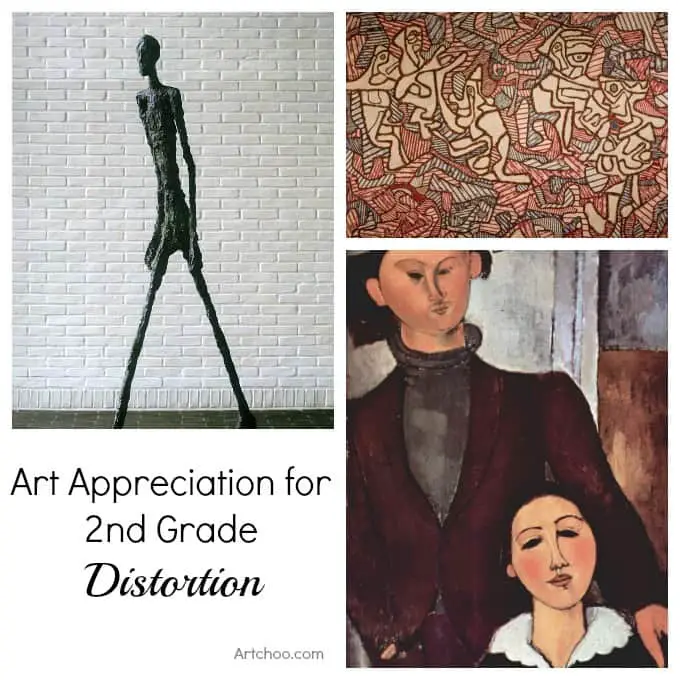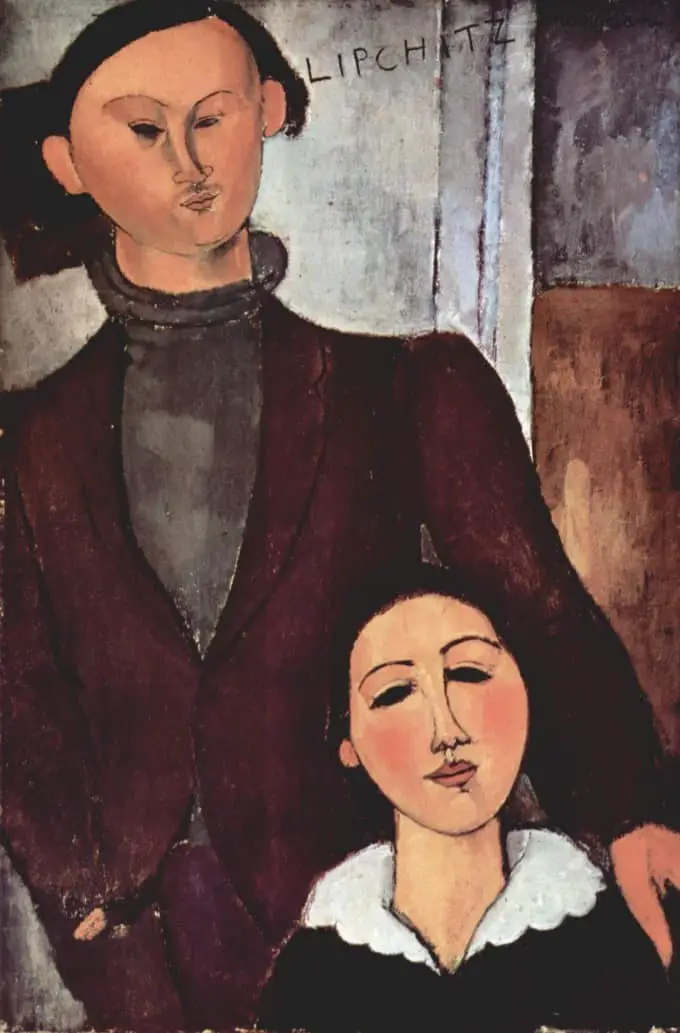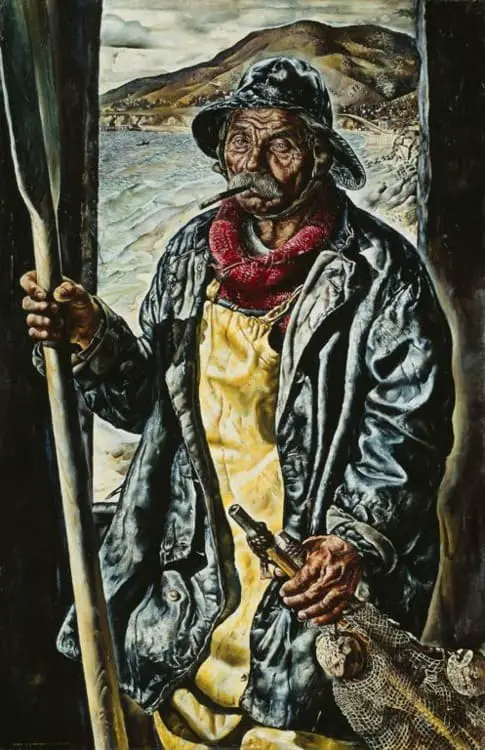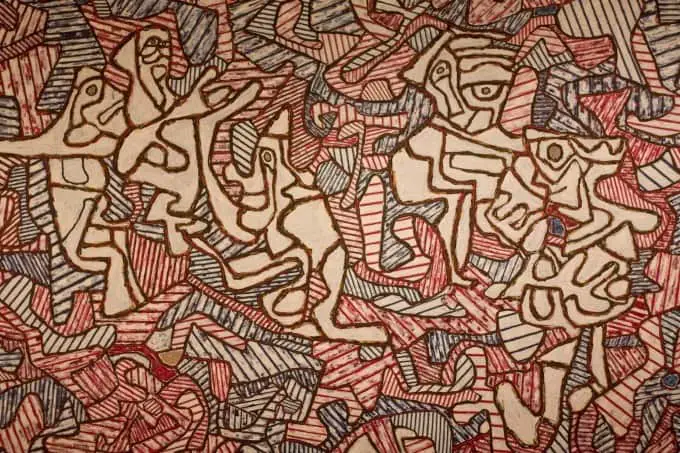Art Appreciation 2nd Grade: Distortion · Craftwhack

This is an art history presentation the kids get excited about because information technology's fun to wait at how artists use distortion in their piece of work- just check out that crazy Giacometti sculpture beneath, and encounter what they have to say about information technology!
*****
Artists use colors, shapes and lines in their works; these are called the elements of fine art. But often they change or exaggerate the natural colors, shapes, or lines to better express some feeling or idea. By looking at works of art done in a distorted manner we tin effigy out what ideas or feelings the artist was trying to express.
Artists don't have to record exactly what they see – the camera does that. Artists are free to draw whatever they desire to in whatever way they like; they can use their imaginations. They often practise so with distortion and so that they can meliorate express some feeling or thought.
Annotation: All artists utilize distortion to some degree. For instance ii artists painting the same tree- ane may emphasize the sunlight on the leaves, another might emphasize the size and shape of the tree in relation to its surround. The finished pictures would await different.
Talk about: Distorted colors, shapes, and lines. Inquire the children what is distorted in the pictures. Let the children point it out first. Ask them what they retrieve the reason is for the distortion; what the artist was trying to express or to say?
Conclusion: Challenge the children to look for other works of art in which the creative person has distorted actual shapes, colors, and lines. Enquire them if they have ever distorted shapes in their own drawings.
Walking man, Alberto Giacometti by andreeastoica on Pictify
Walking Man, Alberto Giacometti, 1960, statuary sculpture, Fine art Institute of Chicago
Ask the Children:
How has this bronze sculpture of a Man Walking been distorted or changed?
- Arms and legs are much longer and thinner than normal
- Artist has said he wanted to show a alone homo- does the baloney of the trunk parts assist evidence the idea of loneliness?
- The sparse body, hunched shoulders, and the long legs and arms all work together to show a person who is all alone.
Talk Most: Distorted colors, shapes, and lines.
- Is this bronze color (a green-chocolate-brown) the natural color of a man? The use of the metal bronze is a baloney or a 'change' in natural appearances.
- The distortion of shape and line are easy to see here. The sculpture is well-nigh six anxiety tall (nearly life-size) just the shapes appear to exist much thinner and longer than normal. The arms and legs have been stretched into long, thin lines.
- Does the man have whatever knees?

Jacques and Berthe Lipchitz, Amedeo Modigliani. 1916. Oil on canvas, 81.iii x 54.3 cm. Art Institute of Chicago
Amedeo Modigliani but lived for 36 years just in that fourth dimension he produced a large number of paintings. He worked as both a sculptor and a painter. The man figure was something he liked to describe and paint.
This painting is of another sculptor, Jacques Lipchitz and his wife, Berthe.
Questions to Inquire the kids:
- How has the creative person distorted or changed the figures? (The adult female looks graceful and gentle only the homo looks tight and pinched)
- Why exercise you remember information technology was painted this style (maybe the artist did not like the sculptor or was trying to say something about his personality. What practise y'all think?
- Enquire them if the figures look realistic
- Simplified shapes of the faces, eyes, etc.
- Flattened out colors/shadows- nigh like masks
- Outlines around figures. Do people really accept outlines around them (the outline is a distortion that emphasizes the simple shapes.)
Background Information (for the presenter):
This painting is at the Art Institute of Chicago. Amedeo Modigliani (1884-1920) was an Italian artist who moved to Paris at the age of 12. He was influenced by the smooth oval faces of primitive African masks that he saw in museums there. Jacques Lipchitz did not like the portrait that Modigliani painted and got rid of it as before long equally Modigliani died.

Heavy the Oar to Him Who is Tired, Heavy the Coat, Heavy the Sea, Ivan Albright, 1929, Fine art Institute of Chicago
Ivan Albright was born and lived here in Chicago. The Art Institute of Chicago has a gallery, or a big room, filled with his paintings. He is known for painting drooping flesh and aging pare and lots of details.
His paintings often accept long, complicated names.
Questions to inquire the Kids:
- Does this human being await tired? Does his coat and the bounding main expect heavy?
- How has the artist distorted things in this painting? (Talk near deep, big lines and exaggerated wrinkles in his skin)
Talk About:
The colors take a wet, silvery expect to them. The shapes are non that distorted. Information technology is the details that are distorted: the wrinkles in the face, the folds in the coat, the waves in the body of water, the clouds in the sky. They are exaggerated. The lines in the human's face are deep and exaggerated. All this distortion gives a feeling of weariness and historic period.

Genuflection of the Bishop, Jean Dubuffet, 1963, Art Institute of Chicago
Questions to Inquire the Kids:
- What do you call up this is? Is it a scribble design? Is it a jigsaw puzzle? Is information technology a motion picture of a person?
- In that location are supposed to be 5 human figures in this painting. See if kids tin find them (Information technology may assistance to look for the optics)
- How tin can we tell these are humans? (They all have a face and the figures are white, not filled in with lines.)
- Can you lot find the effigy that is genuflecting? (kneeling)
- Exercise you think you could make a pattern similar this? How would you do it?
Talk about:
- The colors are a distortion considering human figures are non really red, white, blue, and black.
- The shapes and lines of the people are distorted (changed) only we tin can still recognize them considering of the optics and their general positions.
Background Data (for the presenter):
This painting is at the Art Institute of Chicago. Jean Dubuffet (1901-1985) was a French artist who liked to putter with ball-point pens and felt-tip markers. He produced free-form images outlined in black and filled in with lines and shading. Dubuffet so began to experiment with paintings using a similar technique in oil paint. In the 1960's Dubuffet extended this technique to produce sculpture, drawings, and animated events, all based on his concept of mental space.
Here'due south your Fine art Appreciation -Distortion Powerpoint if you prefer. Hop on over to my Art History for Kids page to see all of the Art Appreciation presentations I've compiled so far.
Source: https://craftwhack.com/art-appreciation-2nd-grade-distortion/
Postar um comentário for "Art Appreciation 2nd Grade: Distortion · Craftwhack"